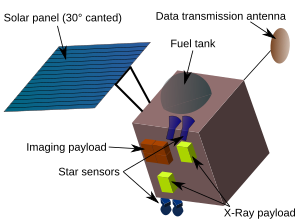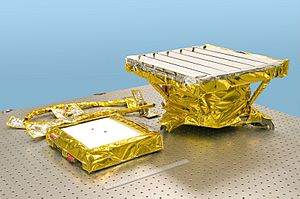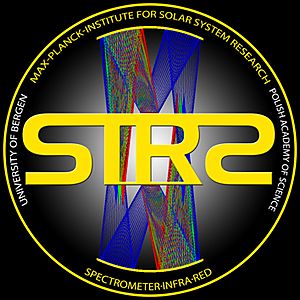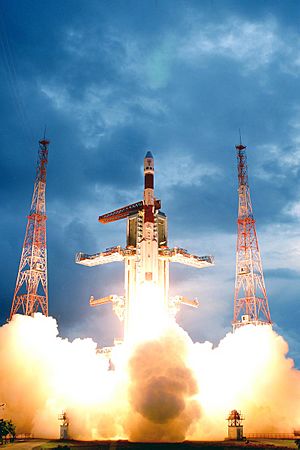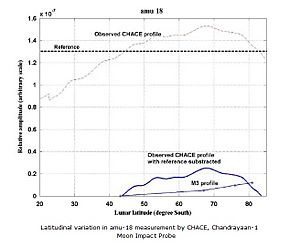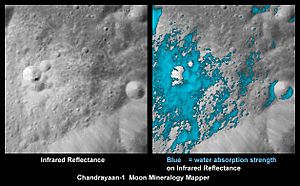Chandrayaan-1 facts for kids
 |
|
| Mission type | Lunar orbiter |
|---|---|
| Operator | Indian Space Research Organisation |
| Mission duration | Planned: 2 years Final: 10 months, 6 days |
| Spacecraft properties | |
| Manufacturer | ISRO |
| Launch mass | 1,380 kg (3,040 lb) |
| Dry mass | 560 kg (1,230 lb) |
| Payload mass | 105 kg (231 lb) |
| Start of mission | |
| Launch date | 22 October 2008, 00:52 UTC |
| Rocket | PSLV-XL C11 |
| Launch site | Satish Dhawan Second Pad |
| Contractor | ISRO |
| End of mission | |
| Last contact | 28 August 2009, 20:00 UTC |
| Orbital parameters | |
| Reference system | Selenocentric |
| Semi-major axis | 1,758 kilometers (1,092 mi) |
| Eccentricity | 0.0 |
| Periselene | 200 km (120 mi) |
| Aposelene | 200 km (120 mi) |
| Epoch | 19 May 2009 |
| Lunar orbiter | |
| Orbital insertion | 8 November 2008 |
| Orbits | 3,400 at EOM |
|
|
|
Chandrayaan-1 (which means "Moon-craft" in Sanskrit) was India's first spacecraft sent to explore the Moon. It was launched by the Indian Space Research Organisation (ISRO) in October 2008. The mission included a spacecraft that orbited the Moon and a small probe that landed on its surface.
India launched Chandrayaan-1 using a PSLV-XL rocket on 22 October 2008. The launch happened from the Satish Dhawan Space Centre in Sriharikota. This mission was a huge step for India's space program. It showed that India could research and build its own technology to explore the Moon. The spacecraft successfully entered orbit around the Moon on 8 November 2008.
On 14 November 2008, a part of the mission called the Moon Impact Probe (MIP) separated from the main Chandrayaan orbiter. It then crashed in a controlled way near the Moon's south pole. With this, ISRO became the fifth space agency to reach the Moon's surface. Other agencies that had done this before were from the Soviet Union (1959), the United States (1962), Japan (1993), and Europe (2006). The spot where the probe landed was named Jawahar Point.
The main goal of Chandrayaan-1 was to study the Moon's surface for two years. It aimed to create a full map of the Moon's chemical makeup and its 3D shape. Scientists were especially interested in the Moon's polar regions because they thought there might be water ice there. One of the mission's biggest discoveries was finding tiny amounts of water molecules spread across the lunar soil.
After almost a year, the spacecraft started having some technical problems. It lost its star tracker (a device for figuring out its direction) and had issues with heat. Chandrayaan-1 stopped communicating on 28 August 2009. Even though it operated for 312 days instead of the planned two years, the mission achieved most of its scientific goals, including finding water on the Moon.
Years later, on 2 July 2016, NASA used ground-based radar to find Chandrayaan-1 still orbiting the Moon. This was almost seven years after it stopped working!
Contents
Why India Explored the Moon
The idea for an Indian mission to the Moon first came up in 1999. India's Prime Minister, Atal Bihari Vajpayee, officially announced the Chandrayaan-1 project on 15 August 2003. This mission was a big boost for India's space program.
Many famous Indian scientists discussed and approved the plan to send a probe to the Moon. Six months later, in November 2003, the Indian government gave its approval for the mission to go ahead.
What Chandrayaan-1 Wanted to Do
The mission had several important goals:
- To build, launch, and send an Indian-made spacecraft to orbit the Moon.
- To use special instruments on the spacecraft to collect data. This data would help:
- To learn more about the Moon and space.
- To test crashing a small probe (the Moon Impact Probe) onto the Moon's surface. This was a practice run for future missions that might try to land softly.
Key Goals for Discovery
To achieve its main objectives, the mission aimed to:
- Map the minerals and chemicals in the Moon's dark polar regions.
- Search for lunar water-ice on or under the surface, especially at the poles.
- Identify chemicals in the Moon's ancient rocks.
- Map the different layers of chemicals in the Moon's crust.
- Measure the height differences across the Moon's surface.
- Observe X-rays and create detailed maps of most of the Moon's surface.
- Help scientists better understand how the Moon formed and changed over time.
How Chandrayaan-1 Was Built
Chandrayaan-1 weighed about 1,380 kg (3,042 lb) at launch. It was shaped like a cube, about 1.5 m (4.9 ft) on each side.
It communicated with Earth using a special antenna. The spacecraft got its power from a solar panel that generated 750 W of power. This power was stored in a battery for when the Moon blocked the Sun.
To move around and stay in orbit, the spacecraft used a special engine and smaller thrusters. It also had star sensors, gyros, and reaction wheels to help it stay pointed in the right direction.
Scientific Tools (Payload)
The spacecraft carried 11 scientific tools, weighing about 90 kg (198 lb). Five of these tools were made in India, and six were from other countries.
Indian Instruments
- TMC (Terrain Mapping Camera): This camera took high-resolution black and white stereo images of the Moon's surface. It helped create a detailed map of the Moon's shape.
- HySI (Hyper Spectral Imager): This camera mapped minerals on the Moon by looking at different colors of light.
- LLRI (Lunar Laser Ranging Instrument): This tool measured the height of the Moon's surface by sending out laser pulses and timing how long they took to bounce back.
- HEX (High Energy X-ray Spectrometer): This instrument measured radioactive elements like uranium and thorium on the Moon.
- MIP (Moon Impact Probe): This was a small probe that separated from the main spacecraft and crashed onto the Moon's south pole. It had a radar to measure its height, a camera to take pictures, and a tool to check the Moon's atmosphere.
Instruments from Other Countries
- C1XS (X-ray Fluorescence Spectrometer): This tool mapped elements like magnesium, aluminium, silicon, calcium, titanium, and iron on the Moon's surface. It was a joint project with the UK and Europe.
- SARA (Sub-keV Atom Reflecting Analyser): From the ESA, this instrument mapped mineral composition using tiny neutral atoms bouncing off the surface.
- M3 (Moon Mineralogy Mapper): From NASA, this tool mapped the mineral makeup of the Moon's surface. It was activated in December 2008.
- SIR-2 (Near Infrared Spectrometer): Also from ESA, this mapped mineral composition using infrared light.
- Mini-SAR (Miniature Synthetic Aperture Radar): From NASA, this radar system searched for water ice, especially at the Moon's poles.
- RADOM-7 (Radiation Dose Monitor Experiment): From Bulgaria, this tool measured the radiation levels around the Moon.
Journey to the Moon
Chandrayaan-1 was launched on 22 October 2008. It used ISRO's tall, four-stage PSLV C11 rocket. Instead of going straight to the Moon, Chandrayaan-1 took a longer path. It circled Earth five times, gradually increasing its orbit over 13 days. This method saved fuel.
ISRO's control center in Bangalore, India, tracked and controlled Chandrayaan-1 throughout its mission.
Entering Lunar Orbit
Chandrayaan-1 successfully entered orbit around the Moon on 8 November 2008. This involved firing its engine for about 13 and a half minutes as it passed close to the Moon. The satellite was placed in an elliptical orbit that went over the Moon's polar regions. With this success, India became the fifth nation to put a spacecraft in lunar orbit.
Over the next few days, the spacecraft's orbit was adjusted several times. By 12 November 2008, Chandrayaan-1 was in its final mission orbit, circling the Moon at a height of 100 km (62 mi). In this orbit, it took about two hours to go around the Moon once.
Moon Impact Probe Lands
The Moon Impact Probe (MIP) crash-landed on the Moon's surface on 14 November 2008. It landed near the Shackleton crater at the south pole. The MIP was one of the 11 scientific tools on Chandrayaan-1.
The MIP separated from the main spacecraft at 100 km (62 mi) above the Moon. It then fell freely for 30 minutes, sending information back to the main satellite, which then sent it to Earth. This event was a test for future missions that might try to land rovers on the Moon.
After the MIP landed, the other scientific instruments on the orbiter were turned on, starting the main part of the mission. Later, based on data from the MIP, ISRO confirmed that there was water in the Moon's soil.
Temperature Issues
In November 2008, ISRO reported that Chandrayaan-1's temperature had risen higher than normal. Scientists thought this was due to unexpected heat in lunar orbit. They managed to lower the temperature by turning the spacecraft and switching off some instruments. Later, it was found that a part of the power system was overheating.
Discoveries and Findings
Chandrayaan-1 made many important discoveries during its mission.
Mapping the Moon
The Moon Mineralogy Mapper (M3), a NASA instrument on board, mapped the minerals on the lunar surface. It found iron and identified changes in rock and mineral composition.
In 2018, scientists re-analyzed M3 data and confirmed that water exists across large areas of the Moon's polar regions.
Chandrayaan-1 also mapped the landing sites of the Apollo Moon missions from the United States.
The spacecraft took over 70,000 images of the Moon's surface. Many of these images were very clear, showing details down to 5 metres (16 ft).
X-Ray Signals and Earth Images
The C1XS X-ray camera detected X-ray signals from elements like aluminium, magnesium, and silicon on the Moon. This happened during a solar flare, which caused these elements to glow with X-rays.
On 25 March 2009, Chandrayaan-1 sent back its first full images of Earth. These images showed Asia, parts of Africa, and Australia, with India in the center.
Orbit Change
After completing its main goals, Chandrayaan-1's orbit was raised from 100 km (62 mi) to 200 km (124 mi) above the Moon. This was done to study how the Moon's gravity affected the orbit and to get wider images of the surface. It was also an attempt to keep the spacecraft cooler.
Radar Scans and Water Ice
The Mini-SAR radar on Chandrayaan-1 imaged many dark areas near the Moon's poles. In March 2010, it was reported that Mini-SAR found more than 40 dark craters near the Moon's north pole. These craters are thought to contain about 600 million metric tons of water ice.
While these findings are exciting, they suggest the ice might be mixed with lunar soil rather than being thick, pure layers.
Lunar Water Discovery
On 18 November 2008, the Moon Impact Probe (MIP) recorded signs of water during its 25-minute descent to the Moon's surface. Later, on 24 September 2009, the Science journal reported that NASA's Moon Mineralogy Mapper (M3) on Chandrayaan-1 had detected water ice. However, ISRO announced that its MIP had actually discovered water three months earlier, but they waited for NASA's confirmation before making it public.
The M3 instrument found special signals on the Moon's surface that usually mean water or related molecules are present. These signals were strongest in cooler, higher latitude areas. This suggests that water is constantly being formed and held on the Moon's surface.
Scientists are now very confident that the Moon has water in many places. It's not just locked inside minerals, but also scattered throughout the broken-up surface. There might even be blocks or sheets of ice deep underground.
Lunar Water Production
Scientists believe that the Moon's surface, made of loose dust and grains (called regolith), absorbs hydrogen from solar winds. When this hydrogen mixes with oxygen in the dust, it can create water molecules.
However, not all hydrogen is absorbed. Some of it bounces back into space. This information is important for future missions to other planets like Mercury.
Lunar Caves
Chandrayaan-1 also took pictures of a long, empty volcanic tunnel under the Moon's surface. This tunnel, found near the Moon's equator, is about 2 km (1.2 mi) long and 360 m (1,180 ft) wide. Scientists think this could be a possible place for humans to live on the Moon in the future.
Moon's Movement (Tectonism)
Data from Chandrayaan-1's radar showed signs of past movement and changes on the Moon's surface. Researchers believe that faults and cracks found could be from the Moon's inner activity combined with meteorite impacts.
Awards for the Mission
Chandrayaan-1 received several awards for its success:
- The American Institute of Aeronautics and Astronautics (AIAA) gave ISRO an award for its important contributions to space science.
- The International Lunar Exploration Working Group gave the Chandrayaan-1 team an award for working with so many international partners (from 20 countries!).
- The US-based National Space Society gave ISRO the 2009 Space Pioneer Award for science and engineering.
The Team Behind Chandrayaan-1
Many dedicated scientists and engineers worked hard to make Chandrayaan-1 a success. Key leaders included G. Madhavan Nair, who was the chairman of ISRO, and Mylswamy Annadurai, the Project Director for Chandrayaan-1. Their teamwork and expertise were crucial for the mission.
Future Missions
Chandrayaan-2 was a follow-up mission launched on 22 July 2019. It included an orbiter, a lander named Vikram, and a robotic lunar rover named Pragyan. Unfortunately, the lander crashed during its attempt to land. A third mission, Chandrayaan-3, was successfully launched on 14 July 2023.
Lunar Outpost Plans
The images from Chandrayaan-1 will help scientists find interesting areas on the Moon. These areas might be explored in more detail by other missions, like NASA's Lunar Reconnaissance Orbiter. Scientists are especially interested in finding lunar water on the surface, as this could be used to help set up a future human outpost on the Moon.
See also
 In Spanish: Chandrayaan-1 para niños
In Spanish: Chandrayaan-1 para niños
- Exploration of the Moon
- Gaganyaan, India's crewed orbital spacecraft
- List of artificial objects on the Moon
- List of current and future lunar missions
- List of Indian satellites
- List of ISRO missions
- Lunar water


